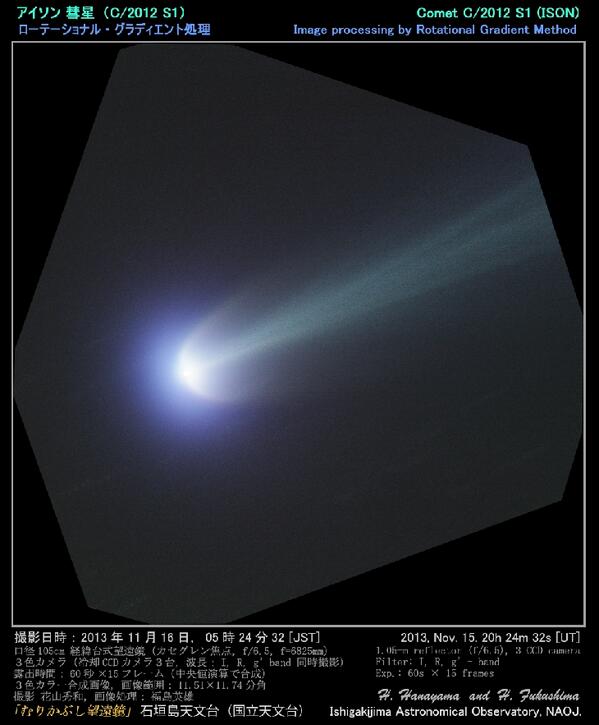by Hukadarn » Sun Nov 17, 2013 1:48 pm
Important update about ISON:
"Central Bureau for Astronomical Telegrams
INTERNATIONAL ASTRONOMICAL UNION
CBAT Director: Daniel W. E. Green; Hoffman Lab 209; Harvard University; 20 Oxford St.; Cambridge, MA 02138; U.S.A.
e-mail:
cbatiau@eps.harvard.edu (alternate
cbat@iau.org)
URL
http://www.cbat.eps.harvard.edu/index.html
Prepared using the Tamkin Foundation Computer Network
COMET C/2012 S1 (ISON)
H. Boehnhardt, C. Tubiana, N. Oklay, and J. B. Vincent, Max Planck
Institute for Solar System Research, Katlenburg-Lindau; and U. Hopp, C. Ries,M. Schmidt, A. Riffeser, and C. Goessl, Astronomical Institute, Ludwig Maximilian University, Munich, report the detection of coma wings in Laplace-filter-processed CCD exposures of comet C/2012 S1 obtained with the 0.4-m telescope of the Mt. Wendelstein Observatory on Nov. 14.16-14.21 and 16.16-16.21 UT. The arclet-like wings appeared in opposite direction from the nucleus at position angles 15 and 195 deg on Nov. 14 and at p.a. 25 and 205 deg on Nov. 16. The coma wings extended straight from the nucleus for about 4700 km on Nov. 14 and 13500 km on Nov. 16 on either side of the extended radius vector and continued in streamers of the plasma tail. No coma wings were found in similar exposures obtained on Nov. 13. The coma wings suggest the presence of two or more sub-nuclei with individual expanding atmospheres in the overall cometary coma and may indicate recent
nucleus splitting in the comet."
In really the nucleus of ISON now shows the same jets estructures like the comet 2001 A2 (LINEAR) and comet C/1999 S4 (LINEAR):
-

-

This jets already cause some evident "wing tails" inside ISON Coma:

Regards !
Important update about ISON:
"Central Bureau for Astronomical Telegrams
INTERNATIONAL ASTRONOMICAL UNION
CBAT Director: Daniel W. E. Green; Hoffman Lab 209; Harvard University; 20 Oxford St.; Cambridge, MA 02138; U.S.A.
e-mail: cbatiau@eps.harvard.edu (alternate cbat@iau.org)
URL http://www.cbat.eps.harvard.edu/index.html
Prepared using the Tamkin Foundation Computer Network
COMET C/2012 S1 (ISON)
H. Boehnhardt, C. Tubiana, N. Oklay, and J. B. Vincent, Max Planck
Institute for Solar System Research, Katlenburg-Lindau; and U. Hopp, C. Ries,M. Schmidt, A. Riffeser, and C. Goessl, Astronomical Institute, Ludwig Maximilian University, Munich, report the detection of coma wings in Laplace-filter-processed CCD exposures of comet C/2012 S1 obtained with the 0.4-m telescope of the Mt. Wendelstein Observatory on Nov. 14.16-14.21 and 16.16-16.21 UT. The arclet-like wings appeared in opposite direction from the nucleus at position angles 15 and 195 deg on Nov. 14 and at p.a. 25 and 205 deg on Nov. 16. The coma wings extended straight from the nucleus for about 4700 km on Nov. 14 and 13500 km on Nov. 16 on either side of the extended radius vector and continued in streamers of the plasma tail. No coma wings were found in similar exposures obtained on Nov. 13. The coma wings suggest the presence of two or more sub-nuclei with individual expanding atmospheres in the overall cometary coma and may indicate recent
nucleus splitting in the comet."
In really the nucleus of ISON now shows the same jets estructures like the comet 2001 A2 (LINEAR) and comet C/1999 S4 (LINEAR):
- [img]http://s10.postimg.org/q9vez3q7t/asas.jpg[/img]
- [img]http://www.ast.cam.ac.uk/~jds,/1999s4_20000721_str.jpg[/img]
This jets already cause some evident "wing tails" inside ISON Coma:
[img]https://pbs.twimg.com/media/BZNWPUKCYAAjylQ.jpg[/img]
Regards !